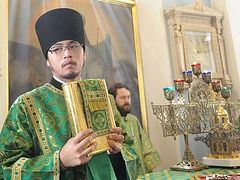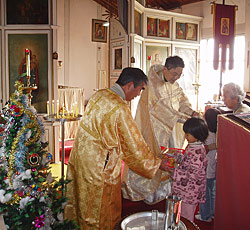 A Nativity service in Handa.
A Nativity service in Handa.
The young Hieromonk Nicholas (Kasatkin), who was appointed rector of this church in place of an elderly priest, Fr. Vasily Makhov, came to Japan in the summer of 1861. In his new motherland the future missionary, following the chronology of events in the Gospel, first of all celebrated the Nativity of 1861/1862, and then, the Radiant Resurrection of Christ. Nativity church services were always particularly solemn in Japan, on a par with Paschal ones.
“After the Liturgy we served the Vespers, and after its dismissal prayer a lectern with the icon of the Nativity of Christ were placed in the middle before the ambo. We came to the middle, the choirs drew close together and sang the troparion of the feast and, ‘Today the Virgin gives birth to Him Who is above being’. At the Liturgy and then at the Vigil we used our translation in the Gospel reading for the first time. Henceforth we will always use this translation so that we can see it ourselves, hear the opinions of others, and correct what needs to be corrected,” wrote Bishop Nicholas on Christmas Eve at the cathedral of Tokyo on December 24, 1895/January 5, 1896.
On the following day the Nativity Liturgy was celebrated. “December 25, 1895/January 6, 1896 is the feast of Nativity of Christ,” writes St. Nicholas in his diary. “The Liturgy of St. Basil the Great began at 9:00. Arseny Ivasava delivered a good sermon on the peace that was brought to people by the Nativity of Christ. The choir sang well. Very many Christians gathered at the service. There were also many foreigners; they seem to have come only to listen to the chants, as they left before the sermon. After the service Fr. Paul Sato with a cross and both choirs glorified Christ in my office and sang in the lower classroom, because there was no room for them in my room where students, teachers and girls who don’t sing gathered at the same time… Having given out sweets to the choristers, I received greetings from Christian men and women, gave icons to the newly baptized (who had been baptized today before the Liturgy), distributed oranges and sweets among children of our clergy and those in minor orders… In the morning, before the Liturgy, I listened to hymns of praise: Dmitry Konstantinovich Lvovsky [choir director of Tokyo Cathedral—G.B.] with children came to greet us, and his three children chanted perfectly the troparion, ‘Thy Nativity, O Christ our God’ in two voices…”
The beauty of Nativity services at the Resurrection Cathedral of Tokyo attracted both the pagan Japanese and Christian Protestant missionaries.
“There were lots of Protestant female missionaries, most probably from America,” St. Nicholas of Japan recalled on December 24, 1896/January 5, 1897. “They waited till the very end and then besieged me upon leaving, so I had to explain them the meaning of the icon that we had venerated; next the ladies asked me to show them the baptistery, and I showed them our font for the baptism of adults and children and explained to them how we perform this Sacrament… The final words of the women missionaries’ escort were: ‘How wonderful your cathedral is!’”
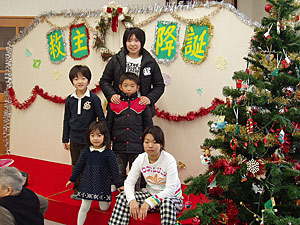 Children’s Christmas show in Hakodate.
Children’s Christmas show in Hakodate.
The saintly Bishop Nicholas was always deeply touched by greetings from the youngest of the parishioners.
“The choir of little congratulators… filled the whole room: sixty kids of both sexes were festively dressed…
“‘Unfold your sheets,’ said their teacher. They did it but kept looking at me and the pictures on the walls, and not at the sheets.
“‘Now sing,’ the teacher commanded, and started himself. The kids joined in the singing and from memory, without looking at their sheets, sang the feast’s troparion so beautifully, harmoniously and melodiously that I was truly moved… I said to them from all my heart that ‘today angels must have glorified the Lord together with you’” (December 26, 1896/January 7, 1897).
Several years later the holy hierarch again mentioned the children’s Nativity greetings in his diary: “Children from the Sunday school sang so nicely that I was listening with great delight to their simple, soulful, and soft-voiced singing” (December 26, 1900/January 8, 1901).
On the feast of the Nativity, students of the Tokyo Theological Seminary would make performances based on episodes from the Gospel. The diaries of St. Nicholas of Japan contain the description of the very first such performance:
“Young people were giving their performance… It was a mystery play composed by one of our senior seminary students, Vasily Nobori, who explained to us its core: ‘Here is the Mediterranean (and he pointed at the part of the room designed for the scenes, after which all the children burst out laughing). Three persons will appear on the stage and they will personify three countries: Egypt, Greece and the Roman Empire at the time of the Birth of Christ…’ And indeed three persons came out: Cyril Mori with a band on his head, covered with something that resembled Egyptian hieroglyphs, and with a palm branch in his hand; Platon Tsukioka, draped in some odd flag of junky white linen with a large ‘Tokyo’ and other signs, with a garland of yellow flowers on his head and a flute in his hand; Nikolai Yosida with a huge bamboo in one hand (symbolizing a spear) and with something else in his other hand (symbolizing some still unexplored weapon), with a tin bucket on his head that represented a helmet, and in some impracticable soldier’s greatcoat. The first personified Egypt, the second—Greece, and the third—Rome; and then a modestly muffled figure came out, at first without being noticed, who represented the All-Holy Virgin Mary, accompanied by the figure of Joseph the Betrothed, portrayed by the bearded Paul Ogava—a catechist school student who borrowed someone’s cassock for that occasion. A small doll that represented the newly born Savior was placed on a dais in the corner next to the tree, and the modest figure (I don’t know which one of our students played the Virgin Mary) was seated beside it with St. Joseph behind. Egypt began his speech, full of disillusionment and despair; then Greece declaimed that the purpose of life was to enjoy your life…; and in conclusion Rome declared that the purpose of life was the conquest of all the peoples and of the whole world. It must be said that their speeches were very clever and pertinent—they expressed the character and worldview of the three peoples quite sharply and clearly. When they finished, the harmonious singing of ‘Glory to God in the highest’ started in the neighboring room; and shepherds, dressed in shirts, came out, one with a sheepskin on his back, and all bowed down before the Nativity of the Savior and spoke of the appearance of angels. This was followed by the star, by the Adoration of the Magi, clothed in some burnouses; ‘Joseph’ received a box of gifts from them and placed it at the ‘Virgin’s’ feet. At that moment, the three figures who represented the three states fell down. The ‘Virgin’ together with the doll and ‘Joseph’ modestly withdrew, while hordes that represented the Goths, the Vandals and others entered and walked over the Mediterranean; and amid them the three fallen figures rose and left through the very doors through which the Goths and the Huns had gone before them. The author came out and reported to us: ‘This has been played not very successfully but it was supposed to mean that Egypt, Greece and Rome revived and followed Christ’” (December 25, 1902/January 7, 1903).
On every Nativity feast, the primate of the Orthodox Church of Japan would receive greetings from each Japanese parish along with missionaries and benefactors from Russia. In the difficult period of the Russo-Japanese War, the Holy Bishop Nicholas especially remembered Nativity greetings that were sent to Tokyo by Russian prisoners of war: “Nine letters of congratulations along with various requests from prisoners of war and a telegram from Konstantin Vasilyevich Uryadov, a lieutenant-colonel in Matsuyama, on behalf of all sick people there” (December 25, 1904/January 7, 1905).
The Nativity and Paschal services were always an original landmark not only for the mission in Tokyo but also for every single Orthodox parish of Japan. Building and reconstruction of churches, and the baptism of catechumens were timed to coincide with these feasts. The main church of every deanery of Orthodox Japan gathered the faithful from neighboring and distant cities and villages. The numbers of participants of festal services were carefully recorded in parish registers. And, beyond all doubt, each Christian dreamed of attending a solemn service at the magnificent Tokyo Cathedral.
“Ioann Ootsuki, a Christian from Takashimizu, has called on me…,” Bishop Nicholas wrote on December 24, 1897/January 5, 1898. “Now the lot has fallen to him to be at the mission cathedral on the feast of Nativity of Christ, and so he has arrived (for the Christians of Takashimizu decided to send a worshipper from their community for the feast of Nativity to the church, and that is really praiseworthy).”
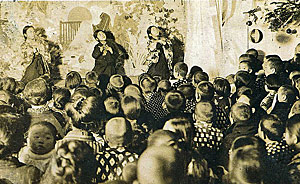 A Christmas play in Shirakawa, Japan, mid-twentieth century.
A Christmas play in Shirakawa, Japan, mid-twentieth century.
The missionary always gladly made special mention of letters from donors and fellow-clergymen who were concerned about strengthening Orthodoxy in Japan:
“Good letters have come from Russia: Her Majesty the Empress consort donated 5,000 rubles for the church, in memory of the prisoners of war who had perished in Osaka… Father Theodore Bystrov writes that ‘Semyon Vasilyevich (a student who was here in summer) is going to read a paper on Japan to divinity students; he wants to direct their attention to the mission.’ May God’s blessing be with him!” (December 25, 1907/January 7, 1908).
St. Nicholas so much wanted the Land of the Rising Sun to receive one more missionary in whom he would find a companion and co-worker: “I prayed fervently to the Holy Apostle Paul, standing in the iconostasis in front of the choir, that he might intercede for us to obtain a new missionary in Japan. I wish the Lord would send us a new missionary through the intercessions of St. Paul, who outdid the gentiles!” (December 25, 1903/January 7, 1904). But it was only in 1908 that Japan saw such a missionary—Bishop Sergius (Tikhomirov), who served the Church of Japan until his very death in 1945.
In January 1912, St. Nicholas celebrated the Nativity of Christ in Japan for the last time.
“We served the Liturgy from 9.00: I, His Eminence Sergius and the priests. The cathedral was packed with worshippers. I had energy and a loud voice. After the Liturgy there were numerous greetings of Christians, clergy, those in minor orders and choristers. Then readers and subdeacons were invited for tea in the clubroom; the choristers who sang the troparion and kontakion were treated with sweets… Next the Sunday school’s greetings followed; again the troparion and kontakion were sung… each was given a certain number of sen [a former monetary unit in Japan equal to one hundredth of a yen—D.L.] and oranges corresponding to his age…” (December 25, 1911/January 7, 1912).
A month and a half later, on February 3/16, 1912, Archbishop Nicholas of Japan reposed in the Lord. Through the efforts of the archpastor’s successor, Metropolitan Sergius (Tikhomirov), the Orthodox Church of Japan continued Her missionary endeavor in this country, which is pagan by nature. In the 1930s, the Orthodox in Japan started celebrating the Nativity of Christ according to the Gregorian calendar, so that believers could, according to tradition, see in the New Year at services and with their families.
However, the transfer of the date did not change the feast’s meaning and spirit: Solemn services are held at the Tokyo Cathedral and at every other parish of Orthodox Japan, and frequently baptisms of children and adults are timed to coincide with the feast. Children’s Christmas shows and performances are held at parishes, and gatherings of parishioners are organized.
The Nativity celebration is especially majestic in Tokyo. The traditional Christmas show, held at the parish meeting house, called Nikolai kaikan in honor of the equal-to-the-apostles missionary, annually brings together over 100 people. These are small children, older adolescents from the Sunday school, Sunday school graduating seniors, and members of the Orthodox youth association attached to the cathedral. A show commences with prayer and a priest’s talk, followed by greeting speeches by the children themselves. Then Sunday school pupils answer questions on the Gospel stories, prepared not only by adults but also by recent Sunday school graduates. “Sacred pictures” are prepared for children and parents—this is a narrative of the Nativity of the Savior, skillfully depicted on sheets of paper. And, of course, all the little ones receive Christmas presents. Similar events are organized in every large and small parish of Japan.
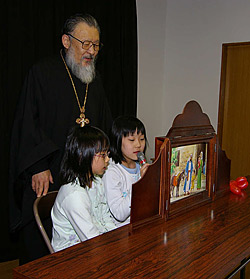 Rector of the church in Sapporo Archpriest Alexis Matsudaira is helping Alexandra Yamaguti and Rebecca Sato show “holy pictures”.
Rector of the church in Sapporo Archpriest Alexis Matsudaira is helping Alexandra Yamaguti and Rebecca Sato show “holy pictures”.
“I want as many children as possible to attend the Sunday school,” writes the five-year-old Anastasia Tanaka who gives an account of a Christmas show at the Tokyo Cathedral. “Let 100 or even 1000 of them come. I wish all of them to be healthy, and that I would always see their smiling faces.” And the words of little Martha Sato indicate the generational continuity in Orthodox Japan: “I will surely sing the songs that I learned during the Nativity play in Church to my granny, who likes singing and prayer so much.”
Another young parishioner from Tokyo, James Ooki, particularly remembered the concentration and attention of the youth who listened to the priest and followed the “holy pictures”: “May this day’s events be imprinted in their young souls, and may these seeds yield prayerful fruit in their adulthood.”
On the Nativity day, as always, the feast’s kontakion was sung in all seventy Orthodox parishes across Japan: “Today the Virgin gives birth to Him Who is above all being…” And, following the example of Holy Equal-to-the-Apostles Nicholas, adult and young believers of the Japanese Orthodox Church prayerfully entreated: “Grant, O Lord, that Japan may soon sing this joyful hymn unto Christ incarnate!” (Diary, December 24, 1896/January 5, 1897).


